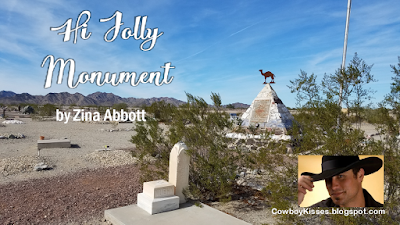Quartzsite is a small town in the middle of the desert where in the winter the wind always blows -- a lot -- constantly. It sure did the couple of days I was there, and I was told it is the norm. It has a certain beauty to it. The town of Quartzsite has an interesting history I will feature in the future, but today it caters to bazillions of snowbirds and others who scatter their RVs across miles of desert -- much of it BLM land -- which can be rented very inexpensively for months at a time for dry camping (as in, no facilities).
In addition to several gas stations, truck stops, groceries and the obligatory fast food, it offers a museum, an out of this world flea market (don't drive down the street with the flea market unless you have a lot of gas in your car and lots of time to kill--it takes forever.) In addition, there are more RVs for sale on sales lots than there are people in Quartzsite.
Beyond that, the big attraction in Quartzsite is the Hi Jolly Monument which is located in the Hi Jolly Quartzsite Cemetery and oversees the graves there.
Remember those camels the U.S. Army brought over to the Southwest in the 1850's? With them came a handler named Haiji Ali. I guess that name was a little bit much for the American soldiers to wrap their tongues around, so he promptly became known as Hi Jolly. I'll tell more of his history in another post, but here is what the sign at the Hi Jolly Monument had to say about him and the camel experiment:
The famous camel herd with which the name of Hi Jolly
is linked constitutes an interesting sidelight of Arizona History….
Jefferson Davis (Afterward president of the Southern
Confederacy), as Secretary of War, approved a plan to experiment with camels
for freighting and communication in the arid southwest….
Major Henry C. Wayne of
the U.S. Army and Lt. D. D. Porter (later a distinguished admiral in the Civil
War) visited the Levant with the storeship Supply and procured 33 camels which
were landed at Indianola, Texas, February 10, 1856. 41 were added on a second
voyage….
With the first camels came, as caretaker, Haiji Ali
whose Arabic name was promptly changed to Hi Jolly by the soldiers, and by this
name he became universally known. His Greek (?) name was Philip Tedro….
On the Beale Expedition in 1857 to open a wagon road
across Arizona from Fort Defiance to California, the camels under Hi Jolly’s
charge proved their worth. Nevertheless, the War Department abandoned the
experiment and the camels were left on the Arizona desert to shift for
themselves, chiefly roaming this particular section [La Paz Valley], they
survived for many years creating interest and excitement….
Officially the camel experiment was a failure. But both
Lt. Beale and Major Wayne were enthusiastic in praise of the animals. A fair
trial might have resulted in complete success.
The following is what was put on the Hi Jolly Monument itself:
The
last camp of Hi Jolly
Born
somewhere in Syria about 1828
Died
at Quartzsite December 16, 1902
Came
to this country February 10, 1856
Cameldriver
– Packer
Scout
– Over thirty years a faithful aid to the U.S. Government
Arizona
Highway Department, 1935
Zina Abbott recently published two books as part of the multi-author series, LOCKETS & LACE.
The first, the prequel to the series, is titled The Bavarian Jeweler.
The other, book 3 in the Lockets & Lace series, is Otto's Offer.







No comments:
Post a Comment